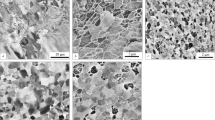Abstract
Heavy-section link-chains are increasingly required to satisfy industrial demands of shipping, lifting, and mining machinery. In this study, the hardenability of link-chain steels with different Si contents was investigated using end-quench tests. The microstructures of the end-quenched specimens were examined by x-ray diffraction, scanning electron microscopy, and transmission electron microscopy. The mechanical properties were investigated by tension tests and impact tests. The effect of the Si content on the phase-transformation temperature during cooling was analyzed by differential scanning calorimetry. It was found that increasing the Si content from 0.24 to 0.74% led to a significant increase in hardenability; the ideal diameter (i.e., the diameter of given steel that would produce 50% martensite at the center when quenched in a hypothetical quenching medium that reduces the surface temperature of the heated steel to the bath temperature in zero time) increased from 187 to 248 mm. Si enhances the hardenability of link-chain steel by affecting its phase-transition behaviors during cooling, including suppressing ferrite formation, inhibiting carbide precipitation, and lowering the temperature of maximum transformation of bainite. The suggested Si content is 0.70-0.75% to produce link-chain steel with high hardenability and good mechanical properties.










Similar content being viewed by others
References
K. Al-Fadhalah, A. Elkholy, and M. Majeed, Failure Analysis of Grade-80 Alloy Steel Towing Chain Links, Eng. Fail. Anal., 2010, 17, p 1542–1550
B.A. Miller, Steel Hardenability and Failure Analysis, J. Fail. Anal. Prev., 2001, 3, p 45–50
S. Yoshida, K. Ushioda, and J. Agren, Kinetic Model of the γ to α Phase Transformation at Grain Boundaries in Boron Bearing Low Alloy Steel, ISIJ Int., 2014, 54, p 685–692
G. Krauss, Solidification, Segregation, and Banding in Carbon and Alloy Steels, Metall. Mater. Trans. B, 2003, 34, p 781–792
L. Meire-Guimarães and D.C.E.S. André-Luiz-Vasconcellos, Evaluating Segregation in HSLA Using Computational Thermodynamics, J. Mater. Res. Technol., 2015, 4, p 353–358
C. Chen, F.C. Zhang, Z.N. Yang, and C.L. Zheng, Superhardenability Behavior of Vanadium in 40CrNiMoV Steel, Mater. Des., 2015, 83, p 422–430
A. Brownrigg and G.K. Prior, Hardenability Reduction in VN Microalloyed Eutectoid Steels, Scr. Mater., 2002, 46, p 357–361
R.N. Penha, J. Vatavuk, A.A. Couto, S.A.D.L. Pereira, S.A.D. Sousa, and L.C.F. Canale, Effect of Chemical Banding on the Local Hardenability in AISI, 4340 Steel Bar, Eng. Fail. Anal., 2015, 53, p 59–68
M. Maalekian, H. Azizi-Alizamini, and M. Militzer, Phase Field Modeling of Microstructure Banding in Steels, Metall. Mater. Trans. A, 2016, 47, p 608–622
E.C. Bain, Factors Affecting the Inherent Hardenability of Steel, J. Mater. Eng. Perform., 2013, 22, p 2732–2775
E. Kozeschnik and H.K.D. Bhadeshia, Influence of Silicon on Cementite Precipitation in Steels, Mater. Sci. Technol., 2008, 24, p 343–347
B.C. De Cooman, Structure–Properties Relationship in TRIP Steels Containing Carbide-Free Bainite, Curr. Opin. Solid State Mater. Sci., 2004, 8, p 285–303
Q. Liu, Z. Liu, X. Wang, G. Liu, Q. He, K. Xie, and J. Sun, Lifespan Assessment of Carbonized Slag Removal Chains by Drysliding Wear Tests, Eng. Fail. Anal., 2018, 93, p 289–299
B. He, Y. Sun, G. Li, and M. Zhao, Mechanical Properties and Strength Analysis of the Ring Chain for Mining Equipment, J. Basic Sci. Eng., 2012, 20, p 828–836 (in Chinese)
N. Li, L. Li, Z. Luo, and J. Li, Crack Analysis of 23MnNiMoCr54 Chain Cable Link, Heat Treat. Met., 2015, 40, p 361–364 (in Chinese)
ASTM A 255-10, Standard Test Methods for Determining Hardenability of Steel, ASTM International, West Conshohocken, 2014
G.E. Totten, Steel Heat Treatment: Metallurgy and Technologies, 2nd ed., CRC Press, Boca Raton, 2006
GB/T 10560-2008, High Tensile Steels of Round Link Chians for Mines (in Chinese).
J. Speer, D.K. Matlock, B.C. De Cooman, and J.G. Schroth, Carbon Partitioning into Austenite After Martensite Transformation, Acta Mater., 2003, 51, p 2611–2622
F. HajyAkbary, J. Sietsma, G. Miyamoto, T. Furuhara, and M.J. Santofimia, Interaction of Carbon Partitioning, Carbide Precipitation and Bainite Formation During the Q&P Process in a Low C steel, Acta Mater, 2016, 104, p 72–83
B. Kim, E. Boucard, T. Sourmail, D. San Martín, N. Gey, and P.E.J. Rivera-Díaz-del-Castillo, The Influence of Silicon in Tempered Martensite: Understanding the Microstructure–Properties Relationship in 0.5-0.6 wt.% C steels, Acta Mater, 2014, 68, p 169–178
M.N. Yoozbashi and S. Yazdani, XRD and TEM Study of Bainitic Ferrite Plate Thickness in Nanostructured, Carbide Free Bainitic Steels, Mater. Chem. Phys., 2015, 160, p 148–154
Z.P. Xiong, A.A. Saleh, R.K.W. Marceau, A.S. Taylor, N.E. Stanford, A.G. Kostryzhev, and E.V. Pereloma, Site-Specific Atomic-Scale Characterization of Retained Austenite in a Strip Cast TRIP Steel, Acta Mater., 2017, 134, p 1–15
S. Hernandez, A. Leiro, M.R. Ripoll, E. Vuorinen, K.G. Sundin, and B. Prakash, High Temperature Three-Body Abrasive Wear of 0.25C 1.42Si Steel with Carbide Free Bainitic (CFB) and Martensitic Microstructures, Wear, 2016, 360-361, p 21–28
Acknowledgments
This work was supported by the Natural Science Foundation—Steel and Iron Foundation of Hebei Province under Grant E2017203041; National Natural Science Foundation of China under Grant 51505416; and Post-Doctoral Research Project of Hebei Province under Grant B2016003029.
Author information
Authors and Affiliations
Corresponding author
Additional information
Publisher's Note
Springer Nature remains neutral with regard to jurisdictional claims in published maps and institutional affiliations.
Rights and permissions
About this article
Cite this article
Wang, Z., Qi, J. & Liu, Y. Effect of Silicon Content on the Hardenability and Mechanical Properties of Link-Chain Steel. J. of Materi Eng and Perform 28, 1678–1684 (2019). https://doi.org/10.1007/s11665-019-03904-8
Received:
Revised:
Published:
Issue Date:
DOI: https://doi.org/10.1007/s11665-019-03904-8




